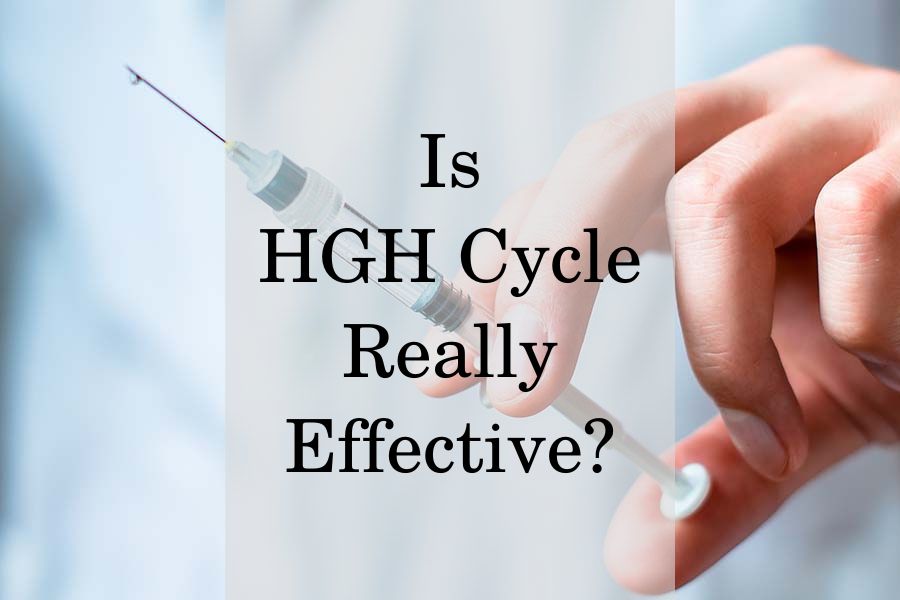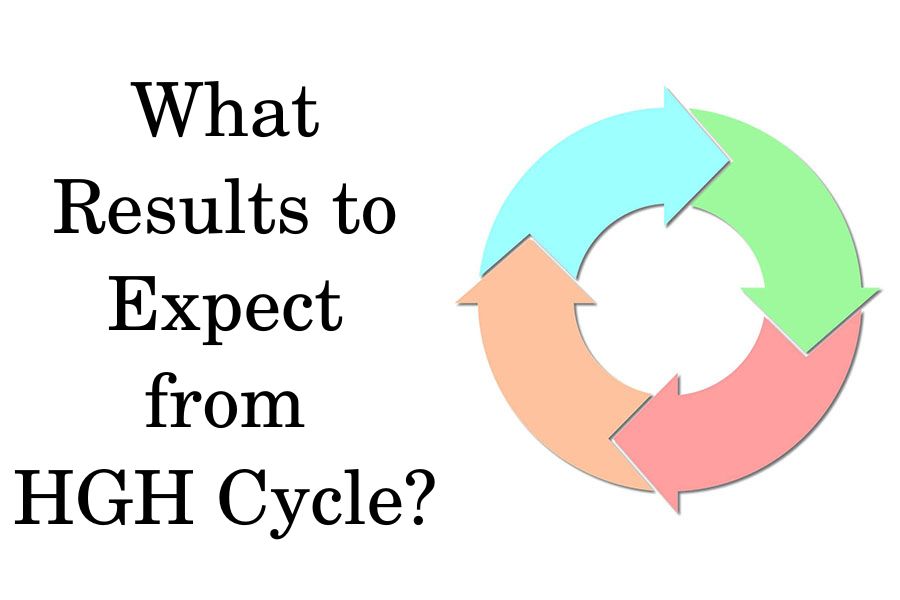
HGH cycling is the practice of taking high doses of human growth hormone (HGH) injections for a limited period followed by a pause.
The method usually involves illegal HGH products which are obtained without a prescription. Such products are unregulated and can be counterfeit, contaminated, or expired.
Typically, people use HGH cycling alongside anabolic steroids in an attempt to improve their physique and performance. But unlike steroids, there is no need to cycle HGH as it does not suppress the function of the pituitary gland.
What is more, it is safe to take HGH continuously as long as you have obtained it with a legal medical prescription and a medical doctor controls your dosage to avoid side effects.
Do you need to cycle HGH?
There is no rationale for cycling HGH injections. That’s because the medication will not suppress the normal function of your endocrine system. That is unlike other performance-enhancing drugs such as anabolic steroids which are cycled off to allow the natural testosterone synthesis to recover.
If you have growth hormone deficiency (GHD) this is the only way to receive effective therapy that will help manage all your debilitating symptoms. Therefore, make sure to consult with a medical doctor if you think you need HGH, and always seek advice from professionals rather than unreliable internet sources.
This does not mean that taking high doses of HGH is not associated with risks and side effects, such as HGH gut. However, adverse reactions can be avoided simply by lowering the dosage.
Taking extreme doses of HGH during a cycle can lead to side effects such as water retention and insulin resistance. Your blood sugar levels may also be affected.
When first starting an HGH cycle, you may experience signs of water retention such as headache, joint pain, swollen legs and feet, and carpal tunnel syndrome due to the high doses.
The dose of HGH during a cycle is much higher than the dose recommended for treating GHD, in an attempt to maximize the muscle-building and fat-burning effects of growth hormone.
After a few weeks, your insulin sensitivity may also get affected. HGH suppresses the action of insulin and your body may develop insulin resistance, which means it can no longer use blood glucose effectively.
HGH dosage on cycle
People who cycle HGH for improving their body composition, usually take doses that are much higher than the officially recommended.
The daily dose can reach anywhere between 3-6 mg which is considerably higher than the recommended 0.2 to 1.2 mg (0.6 to 3.6 IU) per day for managing the symptoms of GHD.
Taking huge doses of HGH can lead to serious side effects especially if the starting dose was high or was increased rapidly. They include water retention and transient hypoglycemia which quickly turns into hyperglycemia.
This can lead to symptoms such as blurred vision, cold sweat, anxiety, extreme weakness, frequent urination, trouble breathing, seizures, and even coma.
Therefore, even a single HGH cycle can lead to serious adverse reactions. These side effects can be avoided by increasing the dose gradually. Therefore, HGH dosage should always be under monitoring by experienced healthcare professionals.
Length of HGH cycle
Most bodybuilders take HGH cycles which usually last 2-6 months, although there is no scientific basis for such practices.
In general, taking an HGH cycle lasts longer than a steroid cycle, as the growth hormone does not suppress the function of the pituitary gland. Furthermore, permanent side effects such as acromegaly develop after years of abusing high doses of HGH.
Taking a short HGH cycle that lasts less than a month does not appear to be associated with any beneficial effects even at doses of 3 mg a day.
HGH shouldn’t be cycled, but the dosage should be increased gradually until you reach optimal serum HGH values and symptom relief
There are rare cases when short-term HGH is officially recommended as a medical therapy. These include patients suffering from conditions associated with severe muscle breakdown and weight loss such as short-bowel syndrome (SBS) and HIV/AIDS.
Currently, scientists report that patients with SBS can take up to 8 mg of HGH a day, as long as the therapy is limited for a month. HIV patients are recommended to take 3-6 mg per day for up to 3 months.
What are the actual results of the HGH cycle?
Growth hormone is widely popular for its anti-aging, fat-burning, energy-promoting, and muscle-building effects. However, some of these effects are prominent only during HGH therapy in GH-deficient individuals, while others even lack scientific proof.
For example, a systematic review of 31 articles reported that taking HGH in doses of 0.014 mg per kilogram of body weight leads to about 2 kg of fat loss and 2 kg lean body mass increase on average in healthy individuals.
Furthermore, your body composition will likely return to its initial state when the HGH cycle ends, as the effects of HGH are not permanent.
On the other hand, long-term HGH therapy in GHD patients can lead to significant improvement in body composition. For example, one study which lasted 10 years reports that long-term HGH can lead to an increase in both muscle mass and muscle strength.
Another trial also reported that 15 years of HGH therapy leads to a significant increase in lean body mass in GHD patients alongside a reduction in fat mass.
Other purported benefits of HGH such as anti-aging are not substantiated by scientific evidence. Scientists warn that HGH can speed up cell proliferation, and this process may actually accelerate aging in some tissues.
In fact, some authors suggest that faster cell proliferation may speed up aging rather than slow it down, especially in older individuals.
Should you stack HGH with steroids?
Stacking HGH with steroids can lead to significant fat loss and muscle gains, simply because of the potent anabolic effects of testosterone and its derivatives. This is accompanied by additional risks of side effects due to steroid abuse such as infertility, impotence, testicular atrophy, hair loss, acne, and more.
Yet, studies show that the benefits of HGH alone are not as significant as one may hope. And cycling HGH on and off does not cause any additional benefits or speed up the results, even at high doses.
What is more, cycling HGH off may easily revert any potential positive changes that occurred during the therapy.
Furthermore, HGH cycling does not appear to improve the benefits or speed up the results of the therapy in patients with GHD.
Instead, cycling off HGH can make your symptoms come back, as your serum growth hormone levels will return to pretreatment levels.
It is much more effective to take HGH continuously to reap all the benefits of the therapy and slowly increase your dosage to let your body adapt and avoid any side effects.
What happens to the gains after coming off the HGH cycle?
Bodybuilders and athletes usually cycle off HGH for 1-2 months, before they start taking it again.
When the HGH cycle ends, your serum growth hormone levels will return to their previous values. During this period all benefits that the injections had, if any, will most likely be lost because the effects of HGH are not permanent.
The difference between HGH and steroids is that, unlike steroids, HGH does not suppress the function of your pituitary gland so you do not need specific post-cycle therapy for HGH.
Cycling off HGH may help lower insulin resistance which occurs with supraphysiological HGH doses. That will however depend on your lifestyle as well.
If you gain a lot of body fat when you cycle off and you reduce your physical activity, this may actually increase your insulin resistance further. Therefore, it is crucial to maintain high physical activity and a healthy body fat percentage, in order to minimize insulin resistance.
Other side effects such as water retention may also worsen, as cycling HGH on and off does not allow the body to adjust to a stable HGH dosage and normalize body water levels.
If you have GHD, discontinuing HGH therapy will also make your symptoms return. That’s why you should not cycle HGH on and off, especially if you have GHD.



 Request Appointment
Request Appointment


